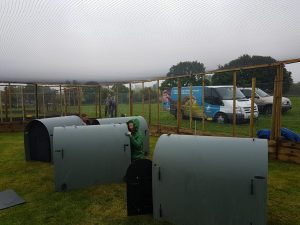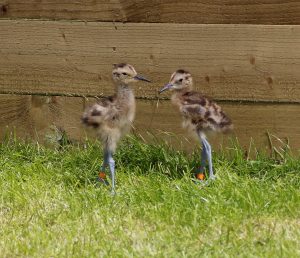Blog by Amber Bicheno, Project Assistant

With summer (supposedly) in full swing, it is the busiest time of year for the Curlew Country Team. We’ve had 40 eggs collected from wild nests, and carefully incubated with help from the Wildfowl and Wetlands Trust. It has been an amazing learning experience for me, to have these expert aviculturists around and pick their brains on the ins and outs of egg development. I’ve had the opportunity to learn how to candle the eggs, which allows us to weed out any infertile or failed eggs. The mid stages of development are particularly fascinating, as you can begin to see the embryo and spidering veins reaching out around the yolk. Once older the visibility within the egg becomes much lower, but the excitement then turns to spotting the movement of the far more developed chick.

At around 27 days the eggs are moved into a hatcher, and it can take another 3 days for the chick to fully emerge. They must dry out completely, and once dry they are at their cutest as long-legged balls of fluff. The chicks are moved to rearing tanks where they will spend the first 7 days of their life. Here their food gets changed every 4 hours throughout the day, with regular cleaning as well (changing mats, blankets, food dishes, disinfecting the floors etc). At 7 days the chicks are moved into the big wide world, or at least their large outdoor rearing pen. The amount of space they get to explore is gradually increased, until they are mixed with other broods in the whole pen. It is from here that the chicks will eventually be released, at a point when they are able to fly.
All this is very well, and although it can result in long days, theoretically a steady routine is in place. This has been somewhat disrupted however by the horrendous June weather we’ve been experiencing for the past week and a half. Chicks have been moved outside during heavy rain, the far less than ideal conditions mean that checks on their progress need to be made each hour. You may think, well why not wait for better weather? In an ideal world we would perhaps try to wait for better conditions, but space was urgently needed in the rearing tanks for the newly hatched broods of chicks.

Fortunately, I can now report that despite these conditions all the chicks (a wonderful 35 in total) are now outside and seem to be fairing much better than us. Unbeknown to the young curlew, the real struggles have come in building the second pen, finding space to dry mats after cleaning, and many pairs of waterproofs being tested to their limits, and above! Recently I’ve been attempting to reproof two of my jackets which haven’t coped well with the relentless rainfall, as well as looking into some new pairs of waterproof trousers (rips far reduce their efficiency it seems).
Our headstarting efforts aside, we still spend much of our time searching and applying for funding to keep us going for another year. In May we held a raffle in aid of the project, with some wonderful donated prizes, and raised an excellent £610 in total. This money has gone into our appeal, and we are hoping to reach the £30,000 point so that we might draw down £10,000 pledged to us from the Whitley Animal Protection Trust. If you would like to donate, you can find out how by clicking here.

It won’t be much longer until these birds are released, and the season will be finished for another year. Our licence continues into 2020, so we hope that we can carry out another year of headstarting and help to offer the population a real boost. Although a temporary measure, it helps to buy time in which to fix the wider issues of predation and habitat loss. It is vital that government realises that farmers are not currently receiving adequate support to help waders, or we could lose them all together.

